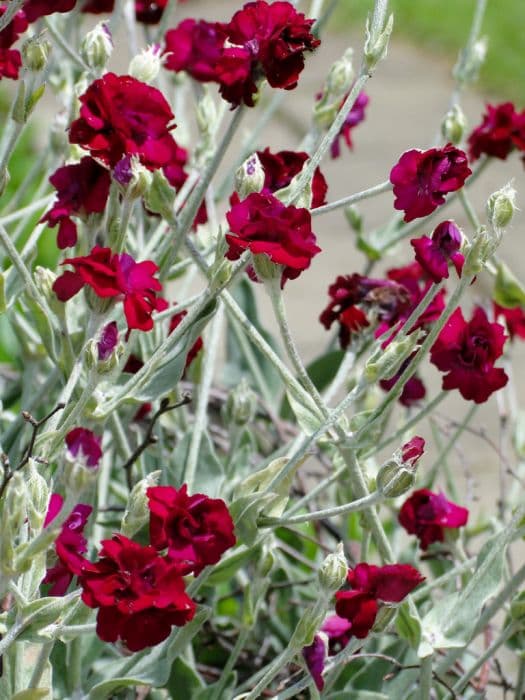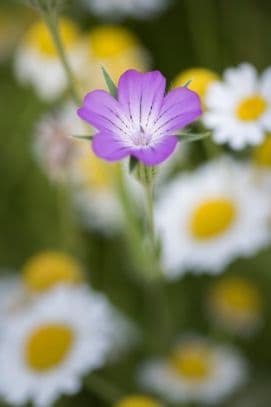Balearic sandwort Arenaria balearica

ABOUT
Arenaria balearica, more commonly known as Balearic sandwort, presents as a low-growing, evergreen perennial with a mat-forming habit. Its appearance is highlighted by a dense cover of small, glossy, bright green leaves which are slightly fleshy and rounded, creating a cushion-like effect. The plant blooms with an array of petite, pure white flowers that possess five petals each, and these flowers emerge in clusters, offering a lovely contrast against the green foliage. The overall appearance of Balearic sandwort is one of a delicate, yet lush ground cover, often used in gardens for rockeries, alpine setups, or as an ornamental feature for its ease of spreading and attractive, year-round foliage.
About this plant
 Names
NamesFamily
Caryophyllaceae
Synonyms
Balearic Sandwort, Corsican Sandwort
Common names
Arenaria grandiflora, Alsinidendron lychnoides, Arenaria grandiflora subsp. psamathodes.
 Toxicity
ToxicityTo humans
Arenaria balearica, commonly known as Balearic sandwort, is not widely recognized for its toxicity to humans. There is limited information suggesting that it is harmful if ingested. However, as with many plants, it is advisable to exercise caution and avoid ingestion since the full spectrum of its effects on humans may not be well documented.
To pets
There is limited information available on the toxicity of Balearic sandwort to pets. It is not typically listed as a toxic plant to cats or dogs. However, the lack of evidence does not necessarily mean it is safe, and caution should be exercised to prevent pets from consuming the plant until more definitive information is available. If you suspect your pet has ingested this plant and is showing signs of illness, contact your veterinarian.
 Characteristics
CharacteristicsLife cycle
Perennials
Foliage type
Evergreen
Color of leaves
Green
Flower color
White
Height
0.3 feet (10 cm)
Spread
0.5 feet (15 cm)
Plant type
Herb
Hardiness zones
8
Native area
Mediterranean
Benefits
 General Benefits
General Benefits- Low Maintenance: Arenaria balearica, commonly known as sandwort, is a hardy plant that typically requires minimal care once established, making it ideal for gardeners seeking low-maintenance options.
- Drought Tolerant: As a plant well-adapted to dry conditions, sandwort is able to survive periods of drought, reducing the need for frequent watering.
- Ground Cover: With its spreading habit, sandwort can act as an effective ground cover, suppressing weeds and minimizing soil erosion.
- Ornamental Value: Sandwort features delicate white flowers and green foliage that can add aesthetic appeal to gardens, particularly rock gardens and alpine settings.
- Wildlife Friendly: The flowers of sandwort can attract beneficial insects to the garden, including bees and butterflies, which are important for pollination.
- Soil Stabilizer: Its dense mat-forming growth aids in stabilizing soil on slopes and in areas prone to erosion.
- Tolerant of Poor Soil: Sandwort can thrive in less fertile soil conditions, making it suitable for planting in areas with poor soil quality.
 Medical Properties
Medical Properties- This plant is not used for medical purposes.
 Air-purifying Qualities
Air-purifying QualitiesThis plant is not specifically known for air purifying qualities.
 Other Uses
Other Uses- Arenaria balearica, also known as Sandwort, can be used in ornamental rock gardens due to its ground-covering form and its ability to grow between rocks and stones.
- Sandwort is valuable in preventing soil erosion on slopes and banks with its network of roots that help to hold the soil together.
- The plant is sometimes used as a lawn alternative in areas with light foot traffic, given its tolerance for drought and low-growing habit.
- In miniature garden arrangements or fairy gardens, Sandwort is often selected for its fine texture and compact growth to simulate grassy landscapes.
- Arenaria balearica may be used as a living mulch because it covers the ground sufficiently to suppress weeds while adding a layer of organic matter as it decomposes.
- It's suitable for planting between paving stones and flagstones, where it can tolerate being occasionally stepped on and can handle some degree of compacted soil.
- Arenaria balearica can be grown in alpine troughs or containers, making it a versatile plant for balcony and patio displays in rocky or sandy soil mixtures.
- Thanks to its diminutive size and preference for well-drained soils, Sandwort is an excellent candidate for green roof systems, helping to insulate buildings and provide habitat for insects.
- In the art of bonsai, Sandwort can be used to create realistic miniature landscapes, offering a sense of scale and organic texture underneath bonsai trees.
- Finally, Sandwort serves as a flowering element in xeriscaping, the practice of landscaping with drought-tolerant plants to reduce the need for irrigation.
Interesting Facts
 Feng Shui
Feng ShuiThe Arenaria balearica, commonly known as the Corsican sandwort, is not used in Feng Shui practice.
 Zodiac Sign Compitability
Zodiac Sign CompitabilityThe Corsican sandwort is not used in astrology practice.
 Plant Symbolism
Plant Symbolism- Purity: The white blossoms of the Balearic sandwort (Arenaria balearica) are often associated with purity due to their pristine color.
- Simplicity: Balearic sandwort has a modest and unassuming appearance, which can be interpreted as a symbol for simplicity and unpretentiousness.
- Adaptability: Growing in rocky and sandy soils, Balearic sandwort demonstrates an ability to adapt to less than ideal conditions, symbolizing resilience and adaptability in life.
 Water
WaterFor the best care of the Sandwort, water it deeply but infrequently to establish a strong root system. Ideally, you should aim to water this plant approximately once a week, providing enough water to penetrate the soil to a depth of at least 1 inch. During the hotter months or periods of drought, water the Sandwort when the top inch of soil becomes dry, which might increase the frequency to twice a week. Always check the soil moisture level before watering to prevent overwatering. An average of 1 gallon per watering session should suffice for a well-established plant, adjusting as necessary for size and environmental conditions.
 Light
LightSandwort thrives in full sun to partial shade. The ideal location for this plant would receive at least 6 hours of sunlight daily, with some relief from the intense afternoon sun if you’re in a particularly hot climate. A spot that gets morning sun and afternoon shade or dappled sunlight throughout the day would be perfect.
 Temperature
TemperatureSandwort prefers temperate climates and can typically handle temperatures ranging from about 30°F to 90°F. The ideal conditions for this plant are between 60°F to 70°F. It may struggle if temperatures consistently drop below freezing or soar above the high end of its tolerance.
 Pruning
PruningPruning Sandwort is important to maintain its appearance and health by removing dead or damaged growth and encouraging bushier, more compact growth. It's best pruned in the early spring before new growth begins. To prune, simply cut back the stems by a third of their length. Pruning should be done annually or as needed to shape the plant.
 Cleaning
CleaningNot needed
 Soil
SoilCorsican Sandwort thrives in well-draining, loamy or sandy soil with a pH between 6.0 and 7.5. A mixture of two parts sand, one part loam, and a handful of gravel to improve drainage makes an ideal soil mix for this plant.
 Repotting
RepottingCorsican Sandwort should be repotted every 2 to 3 years to refresh the soil and prevent the plant from becoming root-bound, which can restrict growth.
 Humidity & Misting
Humidity & MistingCorsican Sandwort prefers a moderate humidity level, but being a Mediterranean plant, it can tolerate some dryness. Aim for humidity levels between 40% and 60% for optimal growth.
 Suitable locations
Suitable locationsIndoor
Place in bright, indirect light with well-draining soil.
Outdoor
Plant in sunny spot with well-draining soil; tolerate partial shade.
Hardiness zone
5-9 USDA
 Life cycle
Life cycleArenaria balearica, known commonly as Balearic sandwort, begins its life cycle with seed germination, which occurs when environmental conditions are favorable, usually in spring or after rain. The seeds develop into small seedlings, establishing a root system and beginning to photosynthesize to grow. As the plant matures, it enters the vegetative stage, where it produces a rosette of leaves and stems; in this phase, the Balearic sandwort grows and strengthens in preparation for reproduction. Flowering occurs next, typically in the spring or summer, during which white to pale pink flowers are produced, attracting pollinators. After successful pollination, the flowers develop into fruit that contains seeds, completing the reproductive cycle. Finally, seeds are dispersed by various means, such as wind or animals, ready to begin the life cycle anew once they find suitable ground for germination.
 Propogation
PropogationPropogation time
Spring-summer
The most popular method of propagation for Arenaria balearica, commonly known as Balearic sandwort, is through seed sowing. Seeds can be sown in fall or early spring, ideally in a cold frame or a sheltered outdoor seedbed. Surface-sow the seeds onto well-drained soil and just lightly press them into the substrate, as they need light to germinate. Keep the soil moist but not waterlogged. Germination can be erratic, so patience is necessary. When seedlings are large enough to handle, transplant them into individual pots and allow them to grow on before planting out into their final position once the risk of frost has passed.






![Pink [Cherry Daiquiri]](/_next/image?url=https%3A%2F%2Fplants-admin.emdemapps.com%2Fimages%2Fplants%2F%2Fimages%2F604b53704a83a.png&w=640&q=75)

![Pink [Passion]](/_next/image?url=https%3A%2F%2Fplants-admin.emdemapps.com%2Fimages%2Fplants%2F%2Fimages%2F604b53b9b9334.png&w=640&q=75)